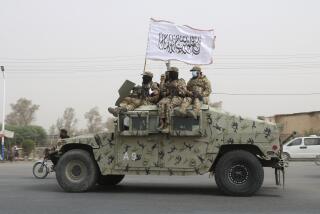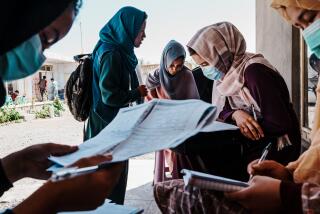Struggles in Afghanistan
PARLIAMENTARY ELECTIONS in Afghanistan three months ago resulted in the most unlikely of career moves for many of the candidates. Once they were warlords or Taliban fighters; now they are legislators who can craft policy to rebuild the country they helped devastate.
The election results offered a troubling portrait of the future for a nation racked by decades of invasion and war. Worse, the balloting has done nothing to stop the killing in the bloodiest year since the United States ousted the Taliban from power four years ago. Insurgents continue to wreak havoc and kill U.S. soldiers and Afghan civilians.
As insurgents borrow a page from the Al Qaeda playbook in Iraq, suicide car bombings, once rare, have become more common. Last month, assailants struck in Kabul, the capital, as two cars rammed into crowds and killed nine people, including a German soldier.
Kidnappings also are on the rise. An Indian working on a road project was kidnapped and killed in November; in August, two Japanese tourists and a British engineer were kidnapped and killed in the south.
Nearly 90 U.S. soldiers have been killed in Afghanistan this year, twice as many as last year. In all, nearly 1,500 people have been killed as insurgent violence has increased.
The U.S. has nearly 20,000 troops in Afghanistan (compared to nearly 160,000 in Iraq). NATO countries are due to patrol more of the country in the coming months, increasing the danger to their soldiers.
With Washington concentrating on Iraq, allies will have to pay closer attention to Afghanistan, where postwar reconstruction is plagued by delays. The International Crisis Group, a nongovernmental organization, urged European Union countries in a report last month to better coordinate their activities.
EU nations contribute more than two-thirds of the 11,000 NATO-led peacekeeping troops -- who operate separately from the U.S. soldiers -- and about one-third of the foreign aid directed to Afghanistan. The peacekeepers patrol relatively quiet areas of the country and provide security for teams building schools, roads and government offices.
The shaky security situation will require continued international involvement in a country where much remains to be done.
It is unsettling that the newly elected National Assembly includes warlords who have plagued Afghanistan for years and resist the authority of President Hamid Karzai, as well as former Taliban soldiers and a onetime provincial governor who presided over the despicable destruction of the 6th century Bamian statues of Buddha.
To counteract their influence, countries attending a U.N. conference next month need to display support of the kind they exhibited after the ouster of the Taliban.
Rebuilding is slow, but aid is still needed to prevent the country from again becoming a failed state and a haven for terrorists.
More to Read
Sign up for Essential California
The most important California stories and recommendations in your inbox every morning.
You may occasionally receive promotional content from the Los Angeles Times.










